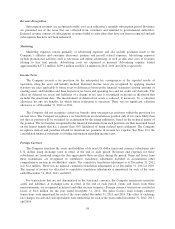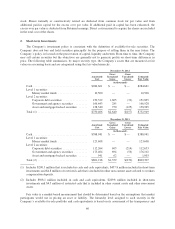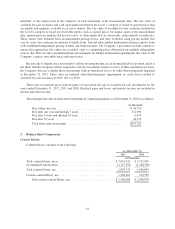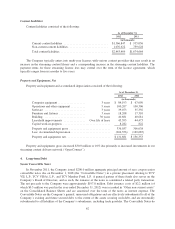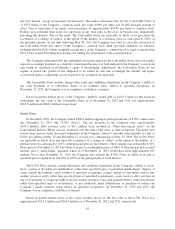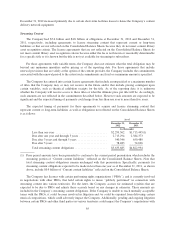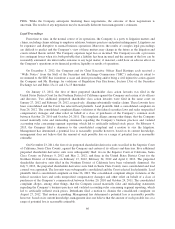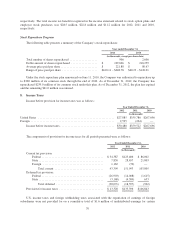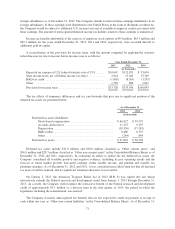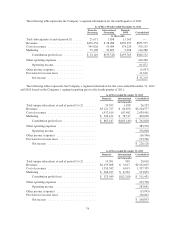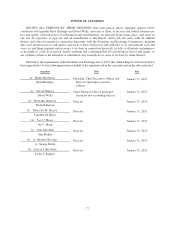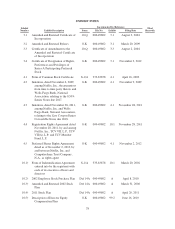NetFlix 2012 Annual Report Download - page 72
Download and view the complete annual report
Please find page 72 of the 2012 NetFlix annual report below. You can navigate through the pages in the report by either clicking on the pages listed below, or by using the keyword search tool below to find specific information within the annual report.
Stock Option Plans
In June 2011, the Company adopted the 2011 Stock Plan. The 2011 Stock Plan provides for the grant of
incentive stock options to employees and for the grant of non-statutory stock options, stock appreciation rights,
restricted stock and restricted stock units to employees, directors and consultants. As of December 31, 2012,
4.0 million shares were reserved for future grants under the 2011 Stock Plan.
In February 2002, the Company adopted the 2002 Stock Plan, which was amended and restated in May
2006. The 2002 Stock Plan provided for the grant of incentive stock options to employees and for the grant of
non-statutory stock options and stock purchase rights to employees, directors and consultants. In the first quarter
of 2012, 1.2 million shares reserved for future grants under the 2002 Stock Plan expired.
A summary of the activities related to the Company’s stock option plans is as follows:
Shares Available
for Grant
Options Outstanding Weighted-
Average
Remaining
Contractual
Term
(in Years)
Aggregate
Intrinsic Value
(in Thousands)
Number of
Shares
Weighted-
Average
Exercise
Price
Balances as of December 31, 2009 ....... 2,591,267 4,241,438 $ 22.74
Granted ........................ (552,765) 552,765 99.58
Exercised ....................... — (1,902,073) 24.75
Balances as of December 31, 2010 ....... 2,038,502 2,892,130 36.11
Authorized ...................... 5,700,000 — —
Granted ........................ (724,994) 724,994 154.09
Exercised ....................... — (659,370) 29.11
Balances as of December 31, 2011 ....... 7,013,508 2,957,754 66.59
Granted ........................ (1,803,798) 1,803,798 73.94
Exercised ....................... — (188,552) 21.85
Canceled ....................... 48 (48) 35.95
Expired ......................... (1,160,721) —
Balances as of December 31, 2012 ....... 4,049,037 4,572,952 71.33 7.05 $163,975
Vested and exercisable at December 31,
2012 ............................. 4,572,952 71.33 7.05 $163,975
The aggregate intrinsic value in the table above represents the total pretax intrinsic value (the difference
between the Company’s closing stock price on the last trading day of 2012 and the exercise price, multiplied by
the number of in-the-money options) that would have been received by the option holders had all option holders
exercised their options on December 31, 2012. This amount changes based on the fair market value of the
Company’s common stock. Total intrinsic value of options exercised for the years ended December 31, 2012,
2011 and 2010 was $14.7 million, $128.1 million and $176.0 million, respectively.
Cash received from option exercises for the years ended December 31, 2012, 2011 and 2010 was
$4.1 million, $19.6 million and $47.1 million, respectively.
Employee Stock Purchase Plan
In February 2002, the Company adopted the 2002 ESPP under which employees purchased common stock of the
Company through accumulated payroll deductions. The purchase price of the common stock acquired by the
employees participating in the ESPP is 85% of the closing price on either the first day of the offering period or the last
day of the purchase period, whichever was lower. Under the ESPP, the offering and purchase periods took place
concurrently in consecutive six month increments. Therefore, the look-back for determining the purchase price was six
68


